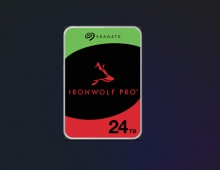SATA 3Gb/s, the Next Generation of Serial ATA Speed
3. Page 3
A SATA 3Gb/s interface on the disc drive can increase system performance when the application takes advantage of the drive’s cache burst ability. In the case of writes, if the drive’s write cache capability is enabled, any write that fits in the buffer will be transferred at the full 3 Gbits/sec into the buffer. In the case of reads, caching helps when the data requested is small enough to fit into the drive cache and is present in the cache at the time of the request. That data will be transferred to the host at the full 3Gbits/ sec rate. In either case, the data must be in the form of small, sequential or near-sequential files, such as those found in some video editing applications. The reason: Small sequential or near-sequential file transfers require less echanical movement or seek overhead and maximize caching capabilities of the drive. In these types of applications, SATA 3Gb/s drive interface rates can greatly increase performance.
While the SATA 3Gb/s interface rate on a single disc is not critical to maximizing the performance of today’s standard desktop computing systems, continuing increases in drive capacity and higher internal data rates driven by increasing disc areal density will create a need for greater interface bandwidth on both the drive and host. Technology that increases areal density will benefit consumers by increasing the amount of data on a single disc platter. More data on less platters means great reliability, less parts and continued low cost per gigabyte. Consumers get a whole lot of technology and capacity at a very low price.
One way drive makers plan to accelerate areal density and data transfer rates is to use a new hard drive technology called perpendicular recording. It increases the amount of data that can be packed onto a square inch of the drive platter, known as the drive’s areal density (bits per inch x tracks per inch), by standing the bits vertically rather than lying them down horizontally. Bits make up sectors and sectors hold your data. Sectors are written on tracks very similar to a record player—in circular layers around the media disc. With perpendicular recording, the bits standing vertically instead of horizontally will allow more room for more sectors, or more of your data. Perpendicular recording promises to eventually increase storage on a single disc drive platter from gigabytes to terabytes, which in turn will require much larger pipes to prevent a data bandwidth bottleneck and spawn a need for faster interface rates in single-drive environments. Several drive makers are expecting to offer perpendicular recording hard drives within the next year.
SATA 3Gb/s will clearly increase performance when system builders take advantage of aggregated bandwidth or multi-drive configurations. But in single-drive environments, the advantages are more limited until the drive data rates increase. Why, then, are motherboard, host controller and drive makers adopting the technology across the board today?
The storage industry historically has avoided performance bottlenecks by ensuring the interface speed exceeds the data rate of the disc drive. The interface rate (1.5 Gbits/sec or 3 Gbits/sec) must never be allowed to constrain the total disc data rate. With more desktop systems taking advantage of aggregated bandwidth RAID and pushing the current interface speed limitations, there is currently a need to expand the host interface rate. In addition, video editing, a prime application for SATA 3Gb/s hard drives, is no longer an experts-only application. Many systems ship with a light version of a digital editing application as a standard feature; while not as widespread as e-mail or surfing the Web, digital video editing is a rising trend. This will drive the adoption of faster drive interface rates as well.
When considering the SATA interface options in systems today, it helps to keep this simple plumbing picture in mind: Disc drives have relatively small internal pipes; they are able to transfer around 60 Mbytes/sec to and from the disc. The interface pipe between the disc and the controller, or host, is capable of transferring 1.5 Gbits/sec today and will have 3-Gbits/sec capability in upcoming SATA systems. If there is only one drive in the system, it doesn’t matter how big the interface pipes are; the system will only be able to pump through data at the rate carried by the smallest pipe (caching situations excepted). If there are multiple drives in the system, the larger interface pipe can carry more data provided by the multiple drives simultaneously, and as the numbers of drives feeding that pipe multiply, more advantage will be seen until the pipe is full. In that case, the advantages of the largest possible pipe will be most obvious, and host-side SATA 3Gb/s will provide system-level performance advantages over today’s SATA 1.5Gb/s. Single-drive performance can also increase with SATA 3Gb/s when working with small files that execute out of the cache. Whether you use SATA 3Gb/s in multi-drive or single configurations you are sure to experience some performance increase. The amount of increase depends on a combination of your workload, your host-side capabilities and your drive’s internal data rate—the interface speed alone is more of an enabler or a path to higher storage performance.
This article is by Seagate and you can find it here.





















